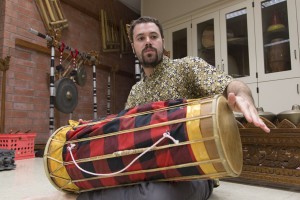Each week, Daily Bruin A&E will explore the instruments of the World Musical Instrument Collection and their performers, that all contribute to the musical landscape of the UCLA Herb Alpert School of Music. This week, we highlight the Balinese gamelan ensemble, a group of instruments from Bali in Indonesia.
A Balinese king closes his eyes at night to the sound of music in his palace. On the Indonesian island of Bali, as early as the 17th century, a 20-to-30-member gamelan ensemble played “Semar Pegulingan” to lull its king to sleep.
After the ships of the Dutch East Indies arrived on the island in the early 20th century, king rule disappeared, and the music that permeated sleeping quarters nearly vanished.
Tyler Yamin, an ethnomusicology graduate student, was once the only person in the world who knew how to play “Semar Pegulingan” after his teacher passed away.
In the summer of 2013, Yamin traveled to the rural Balinese village of Kamasan to learn the music from a goldsmith, I Wayan Sumendra, the only person who Yamin said knew the traditional piece of music at the time.

It was Yamin’s sixth trip to Bali to learn the island’s music – an endeavor he pursued after he took a Balinese gamelan class as an undergraduate at the California Institute of the Arts.
“I realized that I wasn’t playing any more guitar – I was just playing gamelan,” said Yamin, who was a student and player of the guitar for eight years prior to becoming a world music student.
About 9,663 miles away from home, Yamin found himself sitting with his teacher fashioning flowers out of gold leaf. When the sun was out, Yamin asked questions about the music, awaiting for sundown when it came time to rehearse.
Yamin spent a month sitting and striking the trompong, an instrument with a line of gongs and kennels, with a mallet. Opposite the instrument, his teacher also sat, playing the piece as Yamin listened along. Balinese music is not read, Yamin said, it is learned from the mallet or “Maguru Panggul.”
One month into Yamin’s trip, however, his teacher passed away, and Yamin felt a responsibility to preserve the music.
The sekehe of Semar Pegulingan Bale Batur, Kamasan – the village’s ensemble – asked Yamin to teach the music to them. Taking the role as the teacher, Yamin sat opposite his students, teaching the music for two weeks.
In America, Yamin used his woodworking skills to hand-build gamelan instruments dedicated to playing “Semar Pegulingan.” He leads a group called “Pandan Arum,” which documents the music by recording it and emailing it to Balinese gamelan musicians back in Kamasan for teaching purposes.
Yamin said the group has been learning the pieces, making sure to preserve it.
“If I weren’t to share it,” Yamin said, “It would disappear.”
Compiled by Gail Acosta, A&E senior staff.
